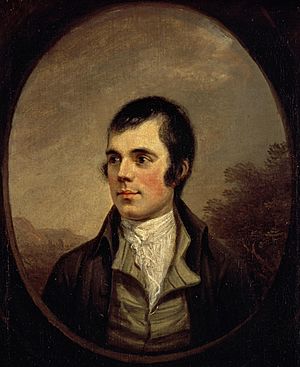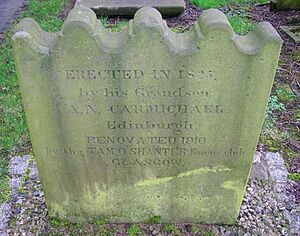Mary Morison facts for kids
Quick facts for kids
Mary Morison
|
|
|---|---|

The gravestone of Mary Morison at Mauchline
|
|
| Born | 1771 Mauchline, Scotland
|
| Died | 29 June 1791 Mauchline, Scotland
|
Mary Morison or Mary Morrison (1771 – June 29, 1791) was a young woman from Mauchline, Scotland. She was the daughter of John Morison, an Adjutant (a military officer who helps with administration). Some people believe she was the "lovely Mary Morison" mentioned in a famous poem by the Scottish poet Robert Burns.
Her gravestone says: "In memory of Adjutant John Morison... also his daughter - the poet's bonnie Mary Morison - who died 29th June, 1791, aged 20."
Mary Morison's Short Life
Mary Morison died very young, at only 20 years old, in 1791. She passed away from a serious lung illness called consumption, which is now known as Tuberculosis. She is buried in the churchyard in Mauchline.
One story says that Mary had a serious accident while riding a horse, which led to her needing a foot removed. This might have caused an infection that led to her death.
Mary lived in Mauchline, but her exact home is debated. She might have lived at a place called 'Brownlea' or in a building known as 'The Place'.
Mary Morison and Robert Burns
Mary's gravestone in Mauchline churchyard states that she was the daughter of Adjutant John Morison. It also says she was Robert Burns's "bonnie Mary" from his well-known song 'Mary Morison'. This gravestone was put up in 1825 by her nephew, A. N. Carmichael, long after Mary and her father had died.
However, local stories suggest that Mary was not very close to the poet. Some say she might have met him only once, during tea at a friend's house. The local minister, Rev Dr Edgar, said that Mary's sister believed her sibling was indeed the "Mary" from the poem.
Most experts, though, think that Robert Burns used the name 'Mary Morison' for another woman named Alison Begbie. Burns himself called the song "one of my juvenile works." This suggests it was written when he was younger. Mary Morison would have been about 14 at the time, and 12 years younger than Burns.
Gilbert, Robert Burns's brother, said that 'Alison Begbie', 'Peggy Alison', and 'Mary Morison' were all names used for the same person: Alison Begbie. The poet found it hard to make Alison Begbie's name rhyme in his songs. So, he first used 'Peggy Alison' and then 'Mary Morison'.
'Mary Morison' is considered one of Burns's best early songs. He wrote it before his first book of poems, 'The Kilmarnock Volume', was published. He later sent the song to George Thomson in 1793.
|
See also



